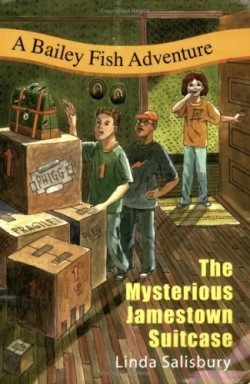
The Mysterious Jamestown Suitcase
A Bailey Fish Adventure--book 4
- 2007 INDIES Finalist
- Finalist, Juvenile Fiction (Children's)
Stolen artifacts pale next to the psychological wallop of this new installment in the popular Bailey Fish Adventure series. Bailey, who lives with her grandmother because her divorced parents both have jobs abroad, finds herself reluctantly embroiled in a furtive effort to open a mysterious green suitcase that belongs to Mr. Phigg, a newcomer to her community. However, the book’s real drama revolves around Sparrow, a wheelchair-bound, silent foster child who comes to live with Bailey’s neighbors, the Keswicks, who have also appeared in the series’ three previous books. Each colorful character contributes to the effort to induce Sparrow to speak.
Bailey and her friends, Fred and Noah Keswick, are intrigued by the battered green suitcase that Mr. Phigg guards so carefully. An evacuee whose home was destroyed by hurricanes, Mr. Phigg is also a writer of children’s books. His current project is a book about Jamestown, “that unfortunate English settlement of 1607.” His research intrigues Bailey and her grandmother so much that they begin exploring the topic themselves. Their content-packed conversations are filled with tidbits such as that John Smith was “captured [by Turks in Hungary] and briefly served as a slave before he escaped.” Mr. Phigg tells Bailey stories about Smith’s famous rescue of Pocahontas, which “are likely his own fabrications.”
Salisbury is the author of seven other books, including three other Bailey Fish Adventures, on which she collaborated with award-winning illustrator and creative designer Christopher Grotke. His humorous detailed sketches provide just the right touch, adding atmosphere to the story by bringing key moments to life. He has also been featured in the New York Times and the Washington Post.
Social issues add texture to this otherwise straightforward mystery, showing Salisbury’s in-depth awareness of the complexities of growing up. Blended families, peer pressure, and domestic violence are among the many issues that Bailey and her friends confront, and the author’s emotional acuity and matter-of-fact approach create an understated sophistication that avoids the melodrama that such issues can invoke. Bailey and her friends respond realistically to the challenges they encounter, and Bailey’s resilience and empathy will impress readers as much as her consistent devotion to school and homework.
When Bailey’s grandmother begins reading more widely about Native Americans, she learns that the Navajo celebrated a child’s first laughter. This chance morsel inspires Bailey to plan a “First Laugh Party” to entice Sparrow to speak. Everyone in Bailey’s extended community contributes to the party preparations, and each person has his or her own idea about how to make Sparrow laugh. The author skillfully brings the distinct threads of her story’s tapestry together when the novel’s suitcase thief is discovered at the party in a surprising disguise.
Reviewed by
Elizabeth Breau
Disclosure: This article is not an endorsement, but a review. The publisher of this book provided free copies of the book to have their book reviewed by a professional reviewer. No fee was paid by the publisher for this review. Foreword Reviews only recommends books that we love. Foreword Magazine, Inc. is disclosing this in accordance with the Federal Trade Commission’s 16 CFR, Part 255.
